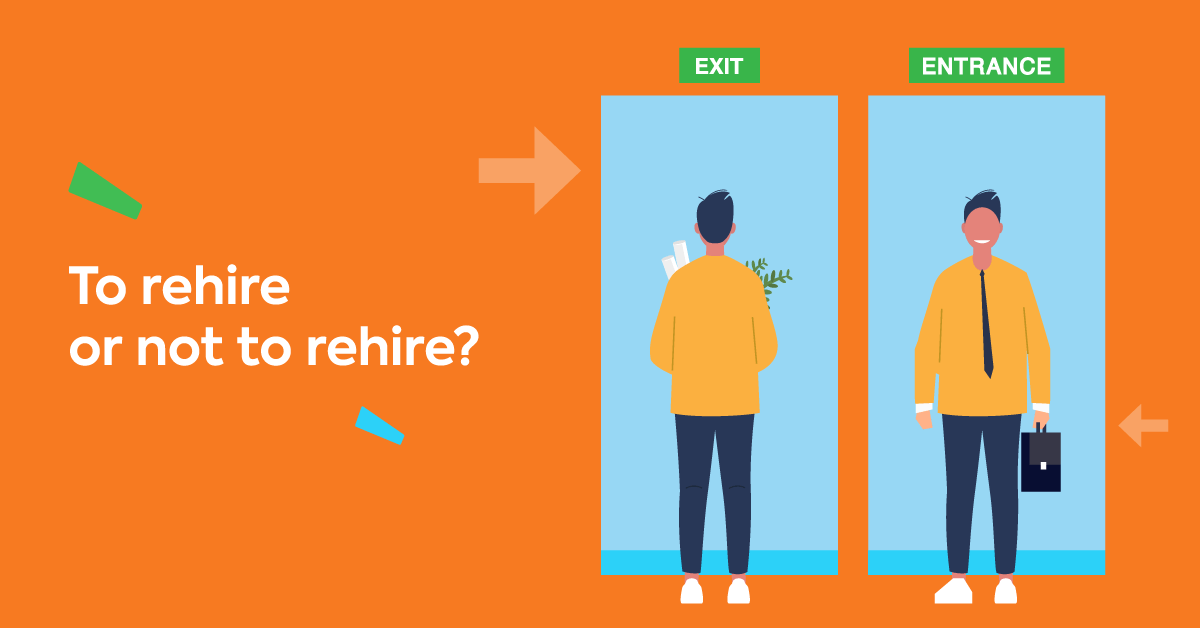When Leona started working as a software developer she was just out of college. Relieved to have secured her first permanent post, and keen to apply the skills she’d studied, it was a dream job. Yes, she had to travel quite a way. And the pay was average. But, it was a rich opportunity to develop her skills, the culture of the company was great, and the people in her team were a perfect match.
Fast forward 10 years later.
Leona’s priorities have shifted. With a partner and two young children to consider, the long, expensive commute is taking its toll on her and her family. Many of her original teammates have moved on. And, having worked a decade for the same company, she’s curious about what she could be missing out on.
So, when she sees an opportunity with a startup just down the road (less travel, more responsibility, more money) it seems like the right time to move on. So she does.
But within 2 years she’s back working with her original employer. And loving it.
Leona’s just one example of a new group of so-called boomerang employees—people who leave a company only to be rehired by them sometime later. So, what made Leona (and many others like her) go back? And why did her previous employer want her to return? Time to dig deeper…
The benefits of rehiring former employees
It’s clear how boomerang employees get their name. But the rationale behind the boomerang employee definition is less clear.
At first glance, rehiring former employees who quit seems odd. After all, they chose to move on, so something can’t have been quite right. And finding a replacement for them was a hassle and expense your company could have done without.
Oddly enough, and while Leona’s story may be fictional, there are lots of people who’ve returned to their former employers. And more and more companies have been adopting a formal rehire policy.
That’s why we talked to a number of different businesses to find out some real examples of hiring boomerang employees.
Here are the benefits they have seen:
1. Agility
Lots of employers take on boomerang employees because time-to-productivity is greatly reduced. For David Bitton, co-founder and CMO of DoorLoop, this agility is a key factor.
“We can get previous workers started on productive work straight away because they don’t need an extensive onboarding regimen,” says David.
“They can more readily integrate into the culture, and have past expertise with internal systems and processes being used. All of this means they can contribute more quickly than a newly hired employee who has no experience working with us, our internal processes and systems, or the culture we’ve created.”
2. Reduced costs
Hiring is expensive and time-consuming. Boomerang employees often offer a better ROI, as banking professional and career coach, Andrew Lokenauth explains.
“It takes time to interview and train a new hire and I would take an old employee back in a heartbeat,” said Andrew. “I had an employee leave for a job with more pay. After a month, he asked if there was any possibility for his old role back. We had a great relationship, so when he sent me a text asking if his old role was filled I got straight back to him.”
Ryan Nieman, developer and CEO at Solitaire, agrees.
“Boomerang employees already know the company rules and regulations,” he said. “This saves me a lot of time and money that would have otherwise been spent on training.”
3. Lower risk
Hiring someone new—however impressive they’re during the hiring process—comes with a lot of unknowns. Boomerang employees are often a safer bet, says Stephen Light, co-owner and CMO at Nolah Mattress, because their track record and work ethic are transparent and already established.
“Rehiring employees who have already proven they were assets to the company can eliminate some of the risk involved in recruitment,” says Stephen. “Which is why we make an effort to keep employees who left the company on good terms part of our network.”
4. Higher retention
According to a BambooHR survey, 31% of new hires quit within their first 6 months at a job. Boomerang employees are more likely to stay after being rehired because they know exactly what’s on offer and how it works for them. Plus, they’ve explored the alternatives and found them lacking.
“It’s hard to find great talent, and sometimes the reason someone leaves a job is no longer relevant,” says John Li, co-founder and CTO of Fig Loans.
“I trust that they wouldn’t return unless the move made sense for them, which means better chances for us of long-term retention.”
Joe Coletta, founder and CEO at 180 Engineering agrees: “Rehiring boomerang employees can also be a way to forge a sense of loyalty, as the process of welcoming someone back creates a sense of enduring connection.”
Overall retention tends to improve, too. Seeing someone return to the company sends out a powerful message to current employees that other options may not be as great as they seem.
5. Time to change
Employers and employees can get stuck in a rut and sometimes need a bit of a jolt to get back on track. Finding out why a good employee left, and making adjustments to accommodate these reasons, brings benefits for both parties.
Sam Shepler, CEO of TestimonialHero, describes a scenario he experienced that was similar to that of (our fictional) Leona’s.
“Timing is a huge part of the employment journey,” says Sam. “Sometimes that’s what happens to employees—the timing is just off.”
He refers to a senior director at a previous company who left because he couldn’t travel as much at that point in his life.
“After a couple of years, we were in want of good talent, and my bosses offered him a position with reviewed responsibilities and flexibility around travel. He accepted and it was a win-win situation for us all.”
6. Familiarity and alignment
“Like returning home after a leave of absence.”
This is how Archie Payne, president at CalTek Staffing, describes the experience of rehiring former employees who quit.
Boomerang employees will already be familiar with your company’s culture, processes, people, and values. And more likely to be in sync and comfortable with them as they know what they sign up for in advance.
When Ryan Nieman, CEO at Solitaire, rehired a former employee this mutual understanding was a big benefit.
“The best part was that they were well aware of the company and its policies,” says Ryan. “So, there wasn’t a lot I had to tell them. Another benefit was knowing that their professional goals aligned with the company.”
7. Insights and improvements
Boomerang employees bring with them new experiences, knowledge, perspectives, and techniques that can take your business onto the next level. As Chelsea Cohen, co-founder of SoStocked, describes:
“Ironically, boomerang employees are often the key to discovering new techniques. If they’ve been working in similar industries or firms, they’ll come back to you with refined workflows that could benefit your entire team.”
According to Solitaire CEO Ryan Nieman, “the number one benefit was the growth and maturity I saw in the employee. The skills they garnered from other companies were visible through their work. This really was a plus point for my organization.”
8. Reality check
When good employees return to the fold, existing employees tend to sit up and take note.
“Bringing back talented and well-respected former employees shows that your company values individuals,” says Ryan O’Donnell, co-founder and CEO at SellHack and Replyify.
As well as being able to attest to improvements since they left, your boomerang employees represent an objective and honest appraisal of your company.
“Having a previous employee return tells current workers that their present job is good since people are eager to return to it,” says Bryan Carter, founder and CEO at ResumeBuilderPro. And that’s a booster to workplace morale.
9. Enthusiasm
Having had time out, boomerang employees often return to their old company and role with renewed energy and enthusiasm.
“An ex-worker who wants back in on the action will do so with more zeal than ever before,” says David Rowland, Head of Digital Marketing at EcoOnline. “This is due to the fact that they may now value aspects of their job that they previously overlooked or didn’t appreciate.”
A view that Archie Payne, president at CalTek Staffing, agrees with.
“Employees who I have personally rehired showed increased loyalty, commitment, and passion for their job,” he says.
Build strong teams with TalentLMS
The training platform that users consistently rank #1.
Easy to set up, easy to use, easy to customize.
Reasons not to rehire former employees
Of course, rehiring former employees who quit isn’t without potential challenges, too. Here are a few red flags our experts identified:
1. Stuck in the past
Even after only a few months, a lot can happen in an organization and there’s a risk your boomerang employee will find it hard to adjust to the changes.
“While the rest of your firm has moved on, boomerang workers may stubbornly adhere to outmoded practices and systems they associate with their previous employment with you,” says David Farkas, founder and CEO of The Upper Ranks.
2. People, perceptions, and politics
Your boomerang employee may be able to slip straight back into doing their old job. But might not slip quite so easily back into their old team. Let’s not forget the impact their return may have on the shift in dynamics since they left.
“Sometimes rehiring an employee may rekindle a bad office relationship.”
Ouriel Lemmel, CEO of WinIt, adds that “employees who have stayed may see this rehiring as rewarding disloyal behavior.”
“Boomerang employees might hold grudges,” notes Irene McConnel, MD of Arielle Executive. “As childish as it sounds, it can be true. And it can lead to friction between employees that can damage team morale.”
To avoid potential friction, consider testing the water with others in the team to see if there are any underlying issues or resentments hidden under the surface.
“Although HR makes the final decision, you should always consult other team members about rehires,” says Chelsea Cohen, co-founder of SoStocked. “Not all workers might have been assets to your company culture.”
3. An identity crisis
Is your boomerang employee a new hire? An old hire? A new old hire? Or something in between? How they’re perceived by others and by themselves is important. Clarify this from the start so there are no misunderstandings or discrepancies around compensation, benefits, or promotion opportunities.
“When you rehire a former employee, technically speaking, they are ‘new hires,’ especially if they’ve been away from the company for a long time,” says Eduarda de Paula, CEO of Coupon Hunt. “But they may see this differently. They could feel entitled compared to other ‘new hires’ and could expect, for instance, special perks and higher compensation as you rehire them.”
Irene McConnel, MD of Arielle Executive agrees. “Other employees could raise issues if your boomerang employee receives the same perks and higher compensation than the previous tenure. This entitlement can further cause a drift between team members.”
4. Best person for the job?
Your boomerang employee may be the safe bet, but are they the best bet? Sometimes expediency and familiarity can cast a heavy shadow over other strong candidates. You’re hiring for the future, not just the present. So, it’s important to keep an open mind and consider all of the talent on the table.
“Seeing a previous employee’s resume in your email may pique your interest to the point where you don’t pay enough attention to the other prospects who are also competing for the job,” says Bryan Carter, founder and CEO at ResumeBuilderPro.
Remaining objective and open is something David Farkas, founder and CEO of the Upper Ranks also stresses.
“You may be passing over the best candidate in your applicant pool by unintentionally preferring the ex-employee,” he says.
5. Higher turnover
We’ve talked about the link between rehiring former employees who quit and better employee retention. But could it work the other way?
“The biggest drawback of rehiring former employees is that it shows other employees that if they leave the risk is lower because we hire people back,” says Todd Ramlin, manager of Cable Compare. “That can lead to higher turnover. Which is why rehiring isn’t our favorite option.”
6. Less new talent
Reaching out to boomerang employees could also send out mixed messages to your talent pool in general. Opting for former employees instead of hiring new people could indicate that you’re hesitating to innovate and try out fresh ideas.
How to rehire boomerang employees
You’ve weighed up the pros and cons and decided to include boomerang employees in your hiring strategy. What next? Our panel offers some tips on the process:
Keep in touch
Put good people who leave your company in a talent pool and send them news about the company, job openings, new benefits, and developments. Having a talent pool makes it easier for a former employee to get in touch, too.
“Over the past year, we’ve hired over 20 former employees,” says Dan Barrett, CEO at Adwords Nerds. And he continues by describing their hiring process. “We have a database of the resumes of former employees which everyone can access. We also have a system that allows us to easily contact former employees and ask them if they are interested in working for us again.”
And, don’t limit your talent pool to long-term, full-time employees.
“You should also add contingent workers—freelancers, independent contractors, consultants—who did a good job and fit the company culture, too,” notes Teo Vanyo, CEO of Stealth Agents.
Don’t onboard, reboard
Onboarding training shouldn’t be ignored when you rehire. Operations and priorities change quickly. And, even if there haven’t been any major changes, most rehires won’t remember everything about the job, your processes, and your policies.
But your boomerang employees won’t need the full, standardized onboarding process. Try instead a tailored reboarding approach by:
1. finding out what knowledge needs refreshing
“Walk through the onboarding checklist and discuss where they need more learning and upskilling, and where they feel comfortable to slide right into the role,” says David Aylor, founder and CEO of David Aylor Law Offices.
“This delivers a customized onboarding process, which is better from a cost-reduction standpoint, too.”
2. providing flexible training options
“In terms of onboarding (or reboarding), we gave our rehires the option of attending any Day 1 activities (formal onboarding),” says Diane Cook, HR specialist at Resume Seed.
“Subsequent onboarding was pared down knowing they had some experience with our systems, policies, and processes.”
3. keeping reboarding current
“You absolutely need to include any culture or policy changes that have happened since the employee last worked for you,” says Jon Hill, chairman and CEO, of The Energists.
“You’ll also want to be mindful of them falling back on old methods or processes for their first few months to make sure they’re on board with the new way of doing things.”
Deliver successful reboarding in just a few clicks
Build online courses with TalentLMS,
and give your new-ish hires a warm welcome.
Seek to understand
Let’s be honest. If you’re considering rehiring former employees who quit, you’ll want to make sure they’re not going to leave again. Key to this is understanding why they left in the first place. An exit interview is a great way to start gathering this information.
“Complete an exit interview and compile exit data when employees resign,” says Archie Payne, president at CalTek Staffing. “This should include questions about why they’re leaving, if they would consider returning, and any concerns they have.”
Follow this up when you reach out and during the interview. But do so tactfully, says Zachary Hoffman, CEO at Digital PR.
“You don’t want the interview to become a ‘How do we know you’re going to stay this time?’ interrogation.”
He also suggests letting the employee lead. “Be open and available to giving them the information they need, and focus on how you’ll evolve or shift the role to better suit their needs.”
Get to know them… again
So, what’s changed since they left? Now’s the time to find out.
“One thing I do differently with rehires is that I request a work portfolio,” says Maria Flores at MediaPeanut.
“Most of our boomerang employees were [originally] hired with little to no experience in our particular industry, so I was interested to see what knowledge and skill sets they acquired after they left.”
Keep it fair
To avoid potential legal challenges (and to keep objectivity front of mind) try to stick to your standard recruitment process where possible.
“During the hiring process, all candidates, including boomerang employees, went through the same recruiting and selection process, because it was ultimately my responsibility to find the best candidate for the job,” says Tony Martins, founder at Profitable Venture.
An approach Diane Cook, HR specialist at Resume Seed reinforces.
“To ensure a fair, equitable recruitment process we didn’t alter too much—we stuck to the same format, same questions, and same interviewers. We did, however, ask them why they wanted to return to the company (after leaving).”

The missing puzzle piece
So, what about Leona? Well, taking time out helped focus the mind—for both employee and employer. Leona had loved her old job and the company. But it was the practicalities that didn’t quite work for her at the time.
And when her previous employer (who’d recently updated its flexible and remote working policies following a review of its exit interviews) reached out, she was more than happy to accept. She’s now working from home three days a week with new childcare benefits in place. And, with the chance to apply for promotion and take on greater challenges as her team grows, her future at the company is secured.
When a good employee decides to walk away, think twice before you smash that door behind them. Ask (them) what it’d take for them to return in the future. And, then, ask (yourself) whether you’d be willing to offer that. If there’s a consensus, when a hiring need comes up, your former employee could be the missing puzzle piece you knew was somewhere near.
| Tags: hiring



